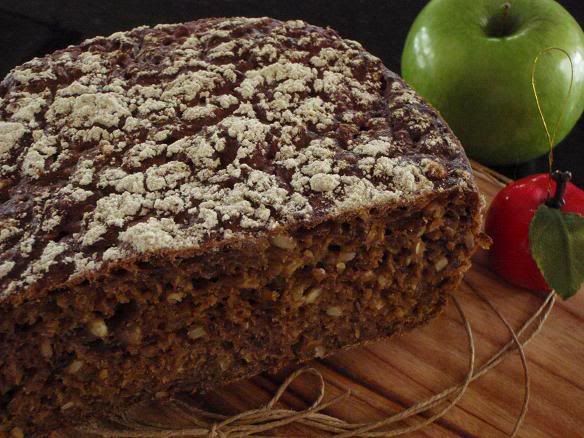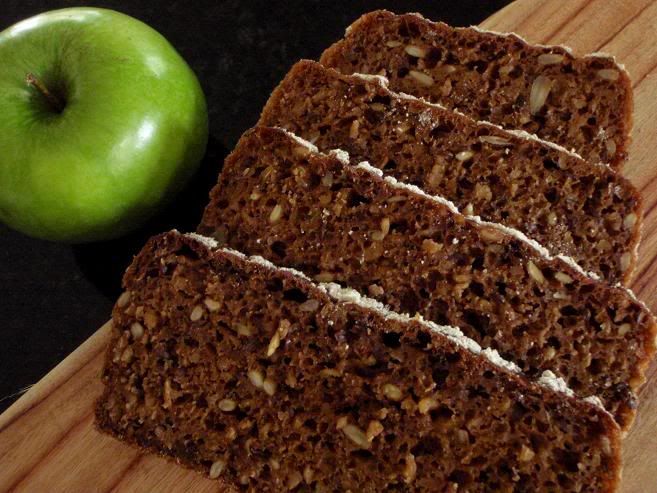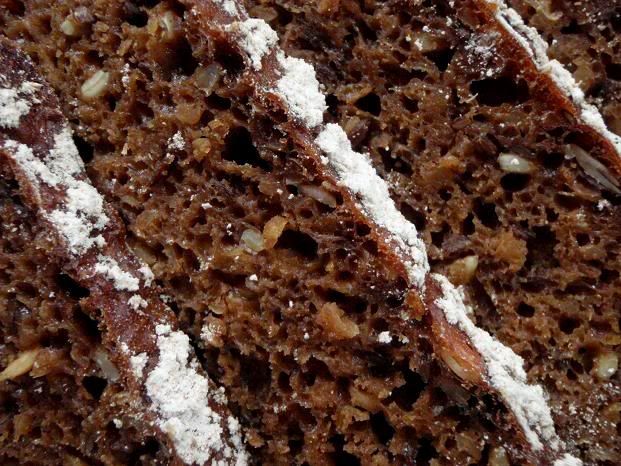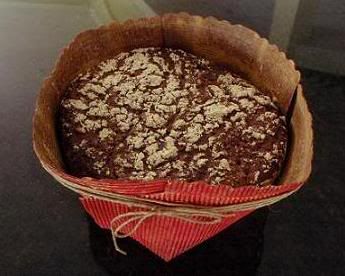The 40-year old Swedish chef-owner, Mathias Dahlgren, has two Michelin-starred restaurants, Bon Lloc and Matsalen, the latter in Stockholm. His style of cuisine is Swedish traditional as well as innovational (a fusion of Scandinavian, Tuscan, Californian and Oriental dishes).
I saw a picture of his Swedish Rye Bread in Coco: 10 World-Leading Masters Choose 100 Contemporary Chefs, page 101, and decided to give it a try. The recipe uses a rye sourdough starter. It also has a high percentage of instant yeast and molasses, which is 4.7% and 19%, respectively, of total flour, rye gains and seeds. The approx. dough hydration is 84%.
The bread is exceptionally moist and flavourful. For a person who does not normally like a lot of rye flour in bread, I find this bread quite delicious. The bitterness from the Black Strap Molasses that I used, together with all the grains and seeds and the fermented rye flour, formed a very interesting flavor and texture.
There is something, however, not quite how I would like it in a fully-loaded bread like this one that, if no changes were made to the recipe, I would probably not make it again. As with the Chinese concept of ying (feminine) and yang (masculine), for something to be balanced, there has to be a ying and a yang element simultaneously. For instance, the enjoyment of a fatty and salty pork chop (the yang) is enhanced if it is eaten with, say, apple sauce (the ying) - the sourness in the apple sauce cuts through the fat while the sweetness in the fruit compliments the saltiness in the meat. Another example: the best chocolate lava cake would have some salt in there, or the sweetness would make you sick.
The issue with this bread for me is: it is perhaps a tad too masculine (too much "yang") because of all the rye grains and seeds in the recipe. I have no doubt that there are plenty of people who love this bread just the way it is. I just have a difference taste. To address the imbalance to my taste, I am adding apple puree as a hydration for the final dough. Also, I have changed the formula to a sourdough version. I find molasses an attractive ingredient to add to a bread full of rye, grains, and seeds but I cut it down in my formula (below) as too much molasses makes the bread bitter (which some people may find it an attractive taste). Here is my Swedish Sourdough Rye Bread with apple puree:

SP's Swedish Sourdough Rye Bread with apple puree
My formula for Swedish Sourdough Rye Bread with Apple
Day 1 - soaker
- 330 g water
- 125 g crushed rye grains
- 43 g rye meal flour (whole rye flour)
- 83 g sunflower seeds
- 53 g linseeds (flax seeds)
- 11 g salt
- 68 g rye sourdough starter (or any ripe starter) @100% hydration
Mix all the ingredients together and let stand at room temperature for 12 hours or at least overnight.
Also on Day 1 - rye sourdough starter (Note: Mathias Dahlgren's original recipe uses instant yeast and so there is no rye sour build.)
- 20 g any ripe starter @ 100% hydration
- 123 g medium rye flour
- 70 g water
Mix the ingredients together and let stand at room temperature for 12 hours or until ripe.
Day 2 - final dough
- 110 g medium rye flour
- 123 g white flour
- 713 g all of the soaker
- 213 g all of the rye sourdough starter
- 70 - 100 g molasses (Note: Mathias Dahlgren's original recipe has 140 g of molasses but I find at that quantity the bread is a bit bitter.)
- 345 g of cooked Granny Smith apple puree or shopped-bought apple sauce (To make your own apple puree, steam 320 g of chopped Granny Smith until cooked, then puree it with 25 g of honey)
Total dough weight 1585 g; estimated dough hydration 84 - 85%.
Procedure
- Mix half of the apple puree with molasses and the other half with the starter.
- Then, mix all ingredients together until thoroughly combined.
- Grease two bread tins. Divide the dough by two and place them in the bread tins. Cover and let rise in a warm place for 3 hours (my room temperature was 28 - 30 C).
- Pre-heat oven to 220C / 425F. Bake with some steam for the first 3 - 5 minutes, then lower the heat to 185C / 365F and bake for a further 40 minutes.
- Turn out the loaves immediately after baking and let cool on a wire rack (or the bottom will be soggy).

My father-in-law and his wife came to stay for Christmas. They are very discerning diners and both keep in good shape. They have been told by their doctor to NOT have too much bread made of wheat flour and that if they must have bread, rye and spelt breads are the best. Whenever they come to visit, I try to make rye and/or spelt sourdough for them. For today's lunch I served this bread. They loved it.


Tomorrow morning, when my father-in-law and his wife leave, they will have this little prezzie, all nicly sliced-up to go.

Shiao-Ping